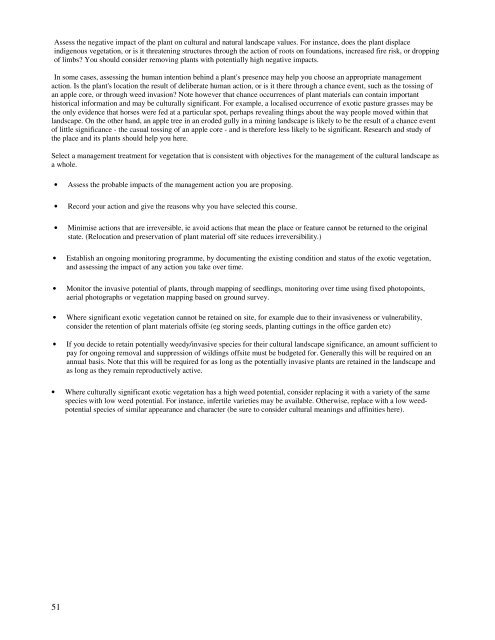Cultural Landscape Management - Australian Alps National Parks
Cultural Landscape Management - Australian Alps National Parks
Cultural Landscape Management - Australian Alps National Parks
Create successful ePaper yourself
Turn your PDF publications into a flip-book with our unique Google optimized e-Paper software.
Assess the negative impact of the plant on cultural and natural landscape values. For instance, does the plant displaceindigenous vegetation, or is it threatening structures through the action of roots on foundations, increased fire risk, or droppingof limbs? You should consider removing plants with potentially high negative impacts.In some cases, assessing the human intention behind a plant's presence may help you choose an appropriate managementaction. Is the plant's location the result of deliberate human action, or is it there through a chance event, such as the tossing ofan apple core, or through weed invasion? Note however that chance occurrences of plant materials can contain importanthistorical information and may be culturally significant. For example, a localised occurrence of exotic pasture grasses may bethe only evidence that horses were fed at a particular spot, perhaps revealing things about the way people moved within thatlandscape. On the other hand, an apple tree in an eroded gully in a mining landscape is likely to be the result of a chance eventof little significance - the casual tossing of an apple core - and is therefore less likely to be significant. Research and study ofthe place and its plants should help you here.Select a management treatment for vegetation that is consistent with objectives for the management of the cultural landscape asa whole.• Assess the probable impacts of the management action you are proposing.• Record your action and give the reasons why you have selected this course.• Minimise actions that are irreversible, ie avoid actions that mean the place or feature cannot be returned to the originalstate. (Relocation and preservation of plant material off site reduces irreversibility.)• Establish an ongoing monitoring programme, by documenting the existing condition and status of the exotic vegetation,and assessing the impact of any action you take over time.• Monitor the invasive potential of plants, through mapping of seedlings, monitoring over time using fixed photopoints,aerial photographs or vegetation mapping based on ground survey.• Where significant exotic vegetation cannot be retained on site, for example due to their invasiveness or vulnerability,consider the retention of plant materials offsite (eg storing seeds, planting cuttings in the office garden etc)• If you decide to retain potentially weedy/invasive species for their cultural landscape significance, an amount sufficient topay for ongoing removal and suppression of wildings offsite must be budgeted for. Generally this will be required on anannual basis. Note that this will be required for as long as the potentially invasive plants are retained in the landscape andas long as they remain reproductively active.• Where culturally significant exotic vegetation has a high weed potential, consider replacing it with a variety of the samespecies with low weed potential. For instance, infertile varieties may be available. Otherwise, replace with a low weedpotentialspecies of similar appearance and character (be sure to consider cultural meanings and affinities here).51
















